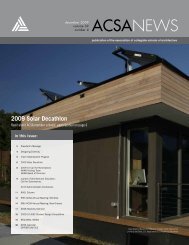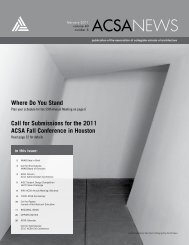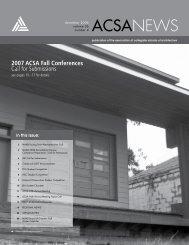digital aptitudes - Association of Collegiate Schools of Architecture
digital aptitudes - Association of Collegiate Schools of Architecture
digital aptitudes - Association of Collegiate Schools of Architecture
You also want an ePaper? Increase the reach of your titles
YUMPU automatically turns print PDFs into web optimized ePapers that Google loves.
THURSDAY, MARCH 1, 2012 - 4:00PM - 5:30PM<br />
Becoming Computational: Restructuring/ Reconsidering<br />
Pedagogy Towards a (More) Computational Discipline<br />
Chris Beorkrem, University <strong>of</strong> North Carolina at Charlotte<br />
Nicholas Senske, University <strong>of</strong> North Carolina at Charlotte<br />
Bootstrapping a Computational Discourse<br />
Maya Przybylski, University <strong>of</strong> Waterloo<br />
This paper discusses work from System Stalker Lab, a third year<br />
undergraduate design studio taught at the University <strong>of</strong> Waterloo.<br />
System Stalker Lab is an introductory exploration <strong>of</strong> design computing,<br />
aiming to instill awareness <strong>of</strong> the key structures and processes<br />
inherent in a design practice inclusive <strong>of</strong> computational strategies<br />
and techniques. The studio also seeks to seed a computationally<br />
oriented design culture within the school by clarifying and speculating<br />
on the opportunities existing within computing in relationship to<br />
architectural design. Such a practice requires that designers expand<br />
their notion <strong>of</strong> <strong>digital</strong> methodologies to include the fundamental<br />
paradigms <strong>of</strong> computer science. The focus <strong>of</strong> the paper is on the first<br />
phase <strong>of</strong> work carried out in the studio, which is committed to building<br />
a workable foundation in algorithmic thinking, representation,<br />
programming and design – core skills required for working within<br />
a computational context. The described process exposes students<br />
to the skills necessary for the conceptualization, design, and execution<br />
<strong>of</strong> a project operating within a computational discourse. Having<br />
completed the first, highly structured phase <strong>of</strong> the studio, students<br />
are enabled to continue to learn independently and to employ computational<br />
design in more open design projects.<br />
Computation as an Ideological Practice<br />
Nathaniel Zuelzke, École Polytechnique Fédérale de Lausanne<br />
Trevor Patt, École Polytechnique Fédérale de Lausanne<br />
Jeffrey Huang, École Polytechnique Fédérale de Lausanne<br />
For computation to become an integral part <strong>of</strong> architectural design,<br />
it must be recognized as an ideological practice. Ins<strong>of</strong>ar as it requires<br />
explicit, precise formalizations <strong>of</strong> the factors which shape any given<br />
project, computation is a strong assertion <strong>of</strong> an author’s ability to<br />
solve a problem. Becoming computational involves acknowledging<br />
this agency and the ways in which it differs from conventional paradigms<br />
<strong>of</strong> authorship, and assessing its impact in the design process.<br />
This paper presents computation within the framework <strong>of</strong> a yearlong<br />
Masters-level design studio <strong>of</strong>fered at École Polytechnique Fédérale<br />
de Lausanne, Switzerland. The studio brief and assumptions<br />
are explained and the notion <strong>of</strong> a “computational engine” is introduced<br />
as an evolving document which clarifies its authors’ intents.<br />
Within the studio, the creation <strong>of</strong> an engine begins with a parametric<br />
site analysis or dynamic mapping <strong>of</strong> the existing context to construct<br />
an understanding <strong>of</strong> the site which possesses a strong authorial<br />
agenda. The temporal, multi-scalar, and diagrammatic nature <strong>of</strong><br />
the engine are discussed.<br />
By considering solution space, computational workflows are contrasted<br />
with conventional ones. Whereas conventional solution<br />
space is largely unstructured and underexplored, the relational,<br />
combinatorial nature <strong>of</strong> computational solution space makes it both<br />
unknowable in advance yet efficient to explore. The integration <strong>of</strong><br />
evaluation metrics and feedback systems into the computational engine<br />
further increases this efficiency without diminishing authorial<br />
will. Finally, some pitfalls are considered, the responsibilities <strong>of</strong> an<br />
author are discussed, and the mechanisms that computation has to<br />
mediate these concerns are recapitulated.<br />
Ultimately, computation should not be viewed as an end in itself,<br />
but rather as an ideological practice which engenders criticality<br />
and promotes innovation.<br />
Computational Design Methods<br />
David Lee, Clemson University<br />
The ACSA Digital Aptitudes Conference celebrates 100 years <strong>of</strong><br />
architectural discourse. Of parallel importance to the theme <strong>of</strong><br />
this session, the event will also mark the 50th anniversary <strong>of</strong> the<br />
internet’s conception. Indeed, Licklider’s concept <strong>of</strong> the ‘Galactic<br />
Network’ marked a revolutionary shift in thinking about how data<br />
sets could be managed and was followed by a series <strong>of</strong> influential<br />
publications that collectively laid the groundwork for the Age <strong>of</strong><br />
Information.<br />
While computation is not inherently about <strong>digital</strong> tools, the advent<br />
<strong>of</strong> the Information Age – spawned by the internet and fueled<br />
by technology such as, mobile computing, social networking, and<br />
GPS – is largely responsible for the current necessity for computational<br />
thought in design. Computational thinking being compulsory<br />
to the various disciplines that employ information processing, it<br />
is critical that architecture schools adopt an attitude that computational<br />
thinking be compulsory to the education <strong>of</strong> the architect.<br />
Moreover, it must be engrained in every aspect <strong>of</strong> a design education,<br />
from beginning to advanced design as well as in practice. This<br />
paper presents a series <strong>of</strong> concepts regarding the role <strong>of</strong> computation<br />
in design, specifically architectural, education. Accompanying<br />
these concepts are a series <strong>of</strong> examples <strong>of</strong> how they have been<br />
carried out in courses I have delivered at all levels <strong>of</strong> an architectural<br />
curriculum.<br />
Integrated BIM and Parametric Modeling: Course Samples<br />
with Multiple Methods and Multiple Phases<br />
Wei Yan, Texas A&M University<br />
This paper presents well designed modeling samples for teaching<br />
integrated BIM and Parametric Modeling in a graduate course.<br />
The samples range from parametric curves, recursive solid models,<br />
to parametric Building Information Models. Implicit and explicit<br />
parametric modeling methods are introduced to the class. Multiple<br />
phases <strong>of</strong> one sample are also exercised. Computer programming<br />
is studied as a powerful method for modeling. The objective <strong>of</strong> integrating<br />
the two powerful modeling methods is to foster critical design<br />
thinking, which is enhanced by the understanding <strong>of</strong> the major<br />
advantages <strong>of</strong> BIM and parametric modeling: Creativity, Constructability,<br />
and Computability (3C’s). The paper describes the samples<br />
and methods in detail and compares the different learning focuses<br />
and limitations <strong>of</strong> the multiple methods.<br />
Digital Apptitutes + Other Openings - Boston, MA - 13








